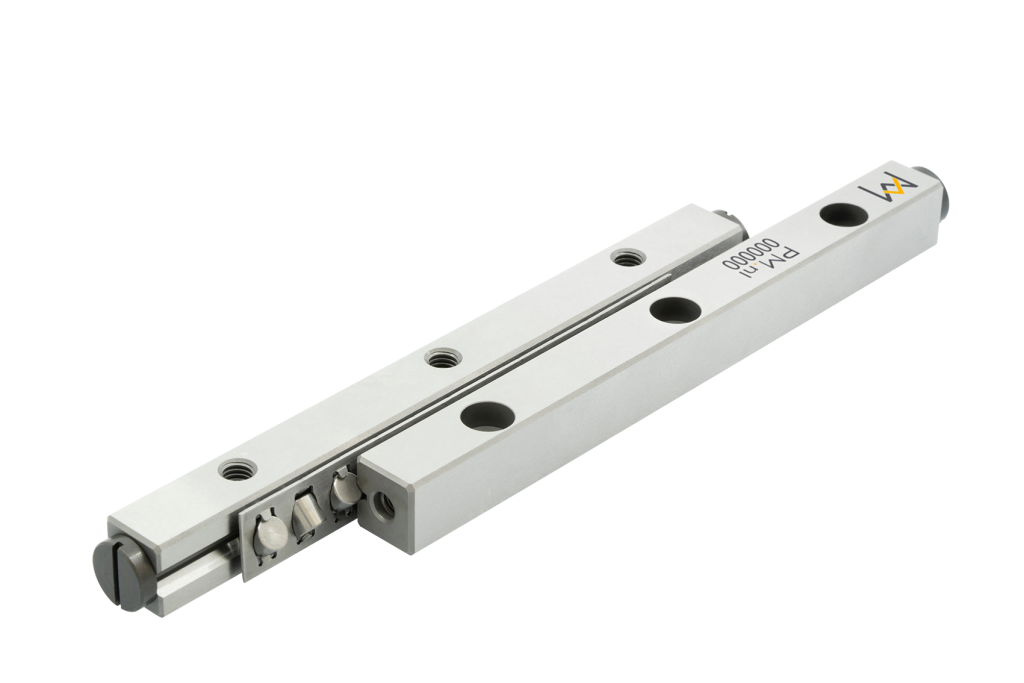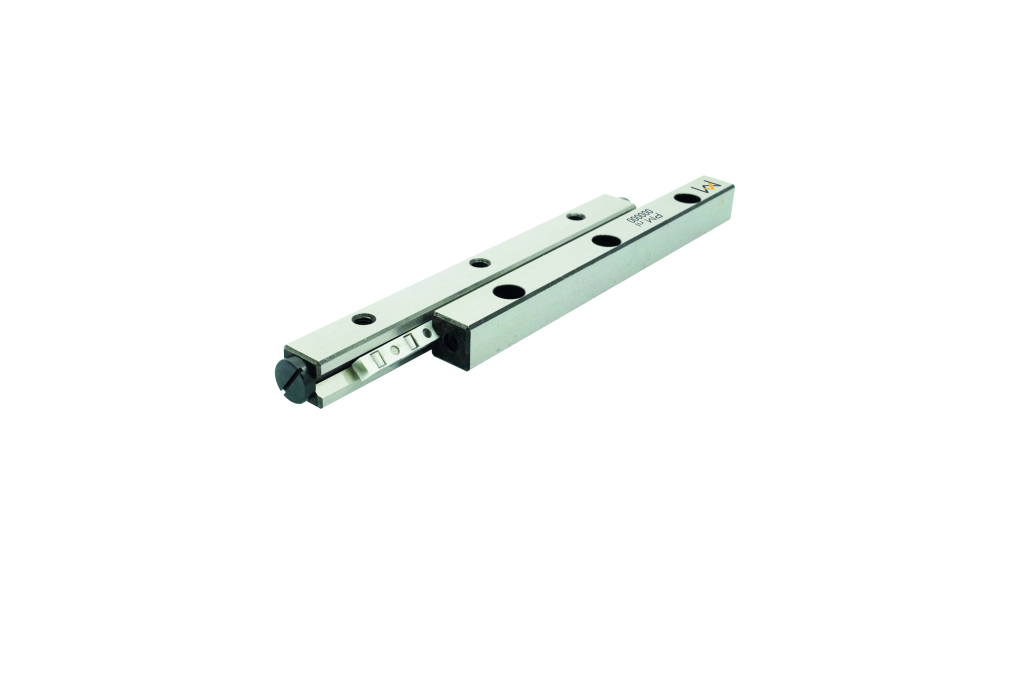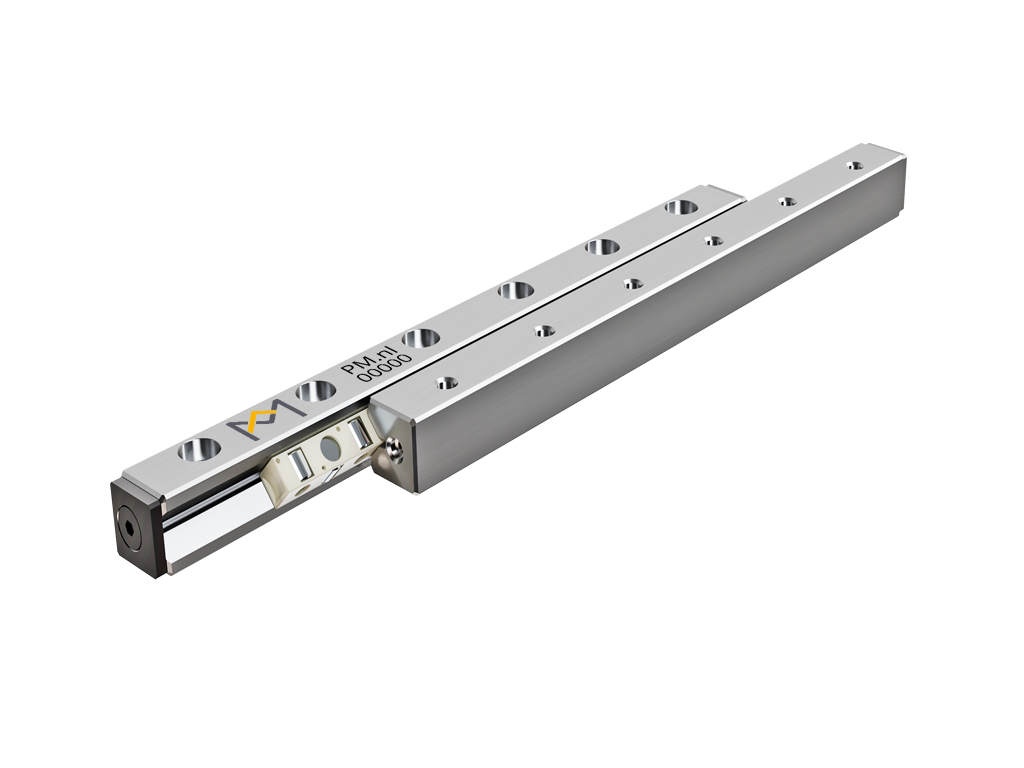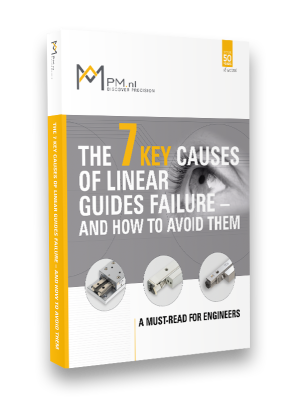
Cross roller linear guides:
overview, characteristics, and applications
Cross roller guides or crossed-roller linear bearings are a popular choice when selecting between different linear guide options, such as needle roller guides or recirculating ball guides. Each linear guide type has its own strengths and suits different applications. In this article, we focus on cross roller guides, exploring their design, features, benefits, and possible drawbacks. We will also look at three modern crossed-roller guide designs used in today’s mechanical engineering applications.
Home » Downloads » Learning center » Linear guides slide way » Cross roller guide slide way
What is a cross roller linear guide?
A cross roller linear guide is a non-recirculating, high-precision linear guide assembly designed for limited stroke applications. It features two parallel, hardened rails with cylindrical rollers arranged at 90-degree angles within a cross roller cage. This design enables exceptionally smooth motion with ultra-low friction (coefficient < 0.003) and provides high rigidity, making it ideal for applications demanding precise and repeatable linear movement.
The basic structure of a cross roller guide includes two pairs of linear guides. Each pair consists of:
- 2 pieces guide rails
- 1 piece cross roller cage
- 4 pieces end stops
The end stops must be inserted at both rail ends. The roller cage contains cylindrical rollers that rotate freely and are arranged in a cross-shaped pattern. These rollers make contact with the raceways of the guide rails.
Watch the video for more detailed information.

Roller arrangement of cross roller guides
The unique roller arrangement in cross roller guides allows them to support loads from all directions, including high overturning moments. Unlike certain linear bearings with recirculating units, all rollers in this arrangement constantly bear the load. In the case of pure radial loads, only half of the rollers engage due to the cross-shaped arrangement.
Providing high load ratings, stiffness, and precision
Compared to ball-caged guides with 4-point contact, cross roller guides offer line contact. This enables them to support higher loads and provide greater stiffness. As a result, cross roller guides deliver higher precision.
Careful assembly process
Due to their high stiffness, cross roller guides are more sensitive to assembly imperfections than ball linear bearings. The mounting surface must be rigid and highly precise. Assembly is a delicate process. For detailed instructions on how to assemble cross roller guides, follow this link.
Applications of use of cross roller guides
Cross roller guides are designed for high-precision load support and object transfer. Common applications include pick-and-place machines, microscopy devices, medical scanning equipment, and precision machines such as semiconductor lithography systems and metrology tools.
This page features videos demonstrating applications of cross roller guides.
Compared to other mechanical linear bearings, cross roller guides offer the highest precision at the nano-micrometer level, excellent repeatability, and minimal friction.
Materials of cross roller guides
Cross roller guides are made from carbon chromium steel (100Cr6). The steel used by PM is exceptionally clean, allowing for tight manufacturing tolerances and consistent product quality. After machining, the material is through-hardened to 58-66 Hrc. This heat treatment process enhances the material’s strength, wear resistance, load capacity, and durability.
For more information about the materials used in our linear guides, click this link.
Advantages of cross roller guide
Cross roller guides offer several key advantages:
- High rigidity and precision: The cross-roller arrangement and line contact ensure high rigidity and precision. The preload can be adjusted to eliminate play and adjust ridigity, providing precision at the sub-micrometer level with excellent repeatability.
- High load capacity: The cross-shaped roller arrangement supports high radial and axial loads, making these guides suitable for dynamic applications.
- Minimal maintenance: Cross roller guides require minimal lubrication, typically only 2-3 times throughout their lifetime.
- Compact design: The compact size of cross roller guides makes them ideal for applications with tight space constraints, such as benchtop devices and automation equipment.
- Durability: Designed for 24/7 use, cross roller guides withstand high loads and extreme conditions.
- Smooth and quiet operation: The precision-finished raceways and cylindrical rollers ensure uniform low friction and absent of noise, resulting in smooth, uniform operation.
Disadvantages of cross roller guides
While cross roller guides have many advantages, there are a few drawbacks to consider:
- Cost: Cross roller guides guides can be more expensive than other types due to their precision manufacturing, straightness, and flatness. Additionally, the mounting components with supporting and reference surfaces, must be accurately machined.
- Careful assembly: Cross roller guides consist of separate components (4 guide rails, 2 roller cages, and 8 end stops), requiring more time and attention during assembly. However, the assembly process is well-documented, making it easier to follow.
- Limited travel: Unlike recirculating blocks in profile rail guides, cross roller guides use a flat cage that floats between two rails. As a result, the travel distance is limited by the rail and cage length. Solutions for longer travel distances are available in certain cases.
- Cage creep: In vertical mounting or high-dynamic applications, the cage may drift from its original position due to gravity or misalignment. PM offers a proven solution to prevent cage drift, which is available for various applications. Click this link for more information about our anti-cage creep solution.
Modern types of cross roller linear guides
To meet the needs of different industries, PM offers three types of modern cross roller guides. For detailed comparisons, follow this link to read our article on the differences between them.
Below, we would like to briefly give a few sentences to the different types.

The classic cross roller guide type RSD
The RSD type cross roller guide is the most widely used and versatile. It offers low friction and accommodates loads and moments from all directions. Available in various sizes, lengths, and cage materials, it is suitable for light to medium loads.
Click here to visit the product page for cross roller guide type RSD.


High-load cross roller guide type RSDE
The high-load cross roller guide type RSDE is designed for higher load capacity, stiffness, and precision at higher speeds. It is available in three sizes (3, 4, and 6 mm) and provides up to three times the load rating of the RSD type. The RSDE guide also features an optional anti-cage creep mechanism.
Click here to visit the product page for high-load cross rolller guide type RSDE.

High-load and compact cross roller guide type RNG
The RNG type combines the advantages of the RSDE type with a more compact design. Available in sizes 4 and 6 mm, it also offers an optional anti-cage creep mechanism.
Click here to visit the product page for compact cross roller guide type RNG.
Click on this link to read an article about the differences in cross roller guides, taking a deep dive into the characteristics of cross roller type precision linear guides.
Summary about cross roller guides
Cross roller guides are the preferred choice for applications requiring high precision. With a wide range of designs, there is a guide for every application, from light to heavy loads. Though assembly requires expertise, the increasing precision and compact dimensions of modern cross roller guides make them ideal for the next generation of machines. Continued development allows these guides to enhance machine output and efficiency.
More relevant articles about cross roller guides
WANT TO KNOW MORE ABOUT OUR PRODUCTS?
Functional Always active
Preferences
Statistics
Marketing
Your catalogue download was successful
Download your e-book
The e-book is written for engineers and includes tips and tricks for the installation of linear guides
- Design tips from experts
- How to avoid commonly made mistakes
- 7 quick wins which will save you money
- Considerations on lubrication
- Clear illustrations
- Special edition written for the engineer
